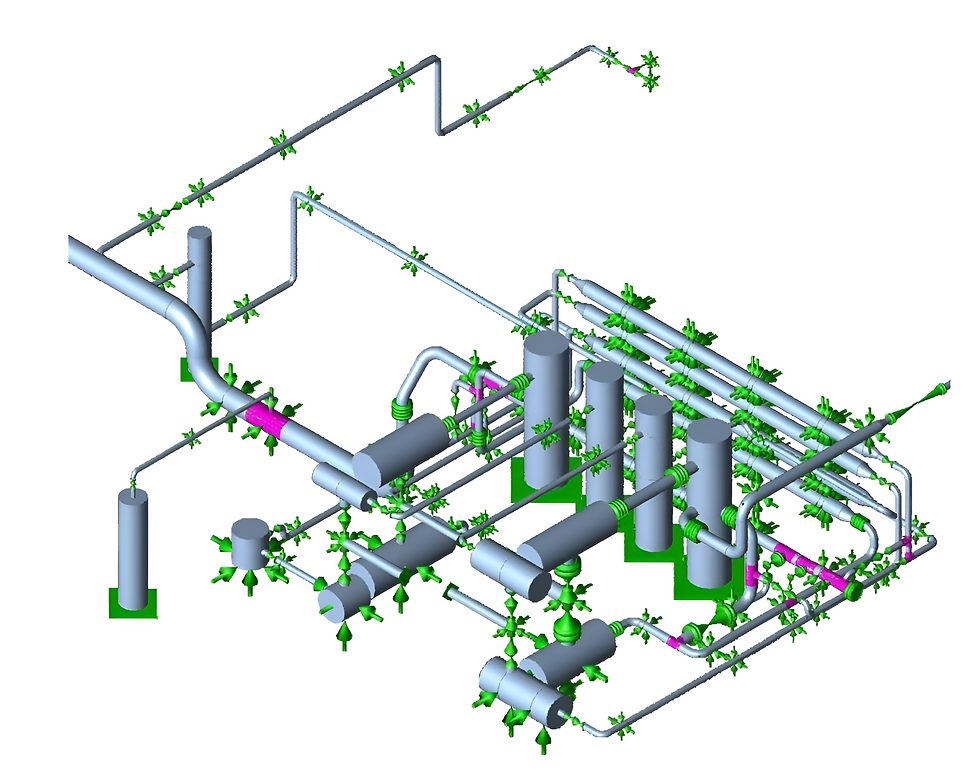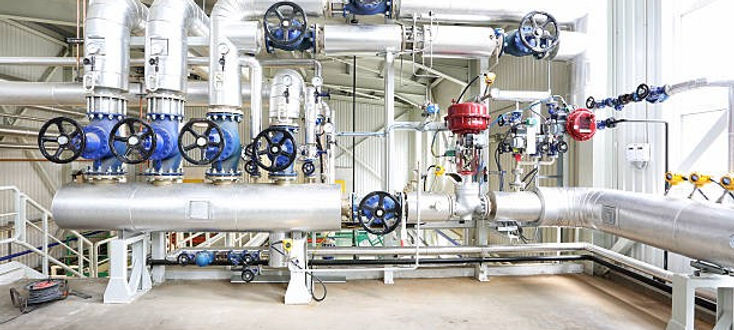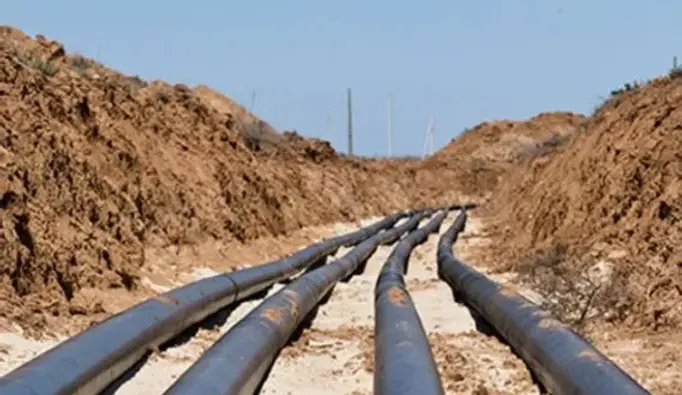
DiVYA
PHONE : +91-8374485831,
Mail : storagetankshy@mail.com
INDUSTRIAL PIPING DESIGN CONULTANCY SERVICES

High temprature Piping Design Services
OIL & GAS, REFINERIES, PROCESS INDUSTRIES
Piping Design Consultants- High Temperature Piping | Divya Engineering
"Divya Engineering offers expert piping design consultancy services specializing in High Temprature piping systems. We provide innovative and cost-effective solutions tailored to your project needs
High-temperature piping refers to the type of piping systems designed to handle fluids at elevated temperatures, typically above 300°F (150°C). These pipes are used in industries like power generation, chemical processing, oil & gas, and many others where the transportation of hot liquids, gases, or steam is necessary.
Key Considerations for High-Temperature Piping:
-
Material Selection:
-
Stainless Steel (e.g., 304, 316, 321) – These materials offer good high-temperature resistance, corrosion resistance, and strength.
-
Alloy Steels (e.g., ASTM A335 P11, P22) – Often used for very high temperatures (up to around 1200°F / 650°C).
-
Carbon Steel – Works well at temperatures up to 800°F (425°C), commonly used for steam or hot water systems.
-
Nickel Alloys (e.g., Inconel) – Can withstand extremely high temperatures and are highly resistant to oxidation and corrosion.
-
-
Thermal Expansion:
-
High temperatures cause pipes to expand and contract. Expansion joints and loops are used to absorb this movement and prevent damage to the system.
-
-
Insulation:
-
High-temperature pipes are usually insulated to reduce heat loss, improve energy efficiency, and protect workers from burns. Materials like fiberglass, calcium silicate, and mineral wool are commonly used for insulation.
-
-
Pressure Resistance:
-
High-temperature fluids, especially in steam systems, may also be under high pressure. Materials for high-temperature piping should be rated for both pressure and temperature.
-
-
Corrosion:
-
Elevated temperatures can lead to accelerated corrosion, especially in environments where water or chemicals are present. Corrosion-resistant materials and coatings are often used to protect the system.
-
-
Welding and Fabrication:
-
High-temperature piping systems often require specialized welding techniques, such as using heat-resistant alloys, and ensuring that welds can withstand thermal stresses.
-
-
Maintenance and Monitoring:
-
The integrity of high-temperature piping needs to be regularly checked for signs of thermal fatigue, corrosion, or material degradation. Inspection techniques like ultrasonic testing, eddy current testing, and visual inspections are used.
-
Applications:
-
Power Plants: Steam and gas turbines, heat exchangers.
-
Chemical Plants: Reactors, distillation columns, and pipes carrying hot chemicals.
-
Oil & Gas: Transporting hot oil, steam injection systems, refining processes.
-
Food & Beverage: Pasteurization lines, heat exchangers.
Challenges:
-
Material Fatigue: The repeated cycles of heating and cooling can cause the material to weaken over time.
-
Thermal Stress: High temperatures can lead to cracks or fractures, particularly at weld joints and connections.
-
Energy Loss: Despite insulation, heat loss through the piping can result in inefficiencies, especially if the insulation degrades over time.
PIPING DESIGN AND DRAFTING
Key Aspects of Their High-Temperature Piping Design and Drafting Services:
-
Thermal Expansion Management: Designing systems to accommodate thermal expansion and contraction, preventing stress and potential damage.Divya Engineering.
-
3D Modeling: Utilizing software such as PDS, PDMS, or Auto Plant to create 3D models for enhanced visualization and accuracy in design.
-
Detailed Drawings: Preparing isometric, fabrication, and erection drawings to guide the construction and installation phases effectively.

PIPING LAYOUT AND ROUTING
ivya Engineering provides specialized services in Piping Layout and Routing for high-temperature applications. Their expertise includes determining optimal pipe layouts to ensure efficient flow, minimize pressure drops, and prevent interference with other equipment or structures. Divya Engineering
Key Aspects of Their Piping Layout and Routing Services:
-
Efficient Flow Design: Strategically planning pipe routes to facilitate smooth fluid movement, reducing energy losses and enhancing system performance.
-
Pressure Drop Minimization: Designing layouts that minimize resistance to flow, thereby reducing pressure losses and improving overall efficiency.
-
Conflict Avoidance: Ensuring that the piping design does not clash with existing equipment, structures, or other utilities, simplifying installation and maintenance.
-
Compliance with Standards: Adhering to industry standards and regulations to ensure safety, reliability, and regulatory compliance in all design aspects.

PIPING SUPPORT DESIGN
Divya Engineering provides specialized services in Piping Support Design for high-temperature piping systems. They focus on designing and specifying supports that properly secure and stabilize the piping system, preventing excessive stress and vibration.
Key Aspects of Their Piping Support Design Services:
-
Support Detail Drawing Preparation: Developing detailed drawings for supports to ensure the stability and safety of the piping system. Divya Engineering
-
Stress and Vibration Control: Designing supports that effectively manage thermal expansion, pressure-induced stresses, and vibrations, thereby maintaining the integrity of the system.
-
Compliance with Standards: Ensuring that all support designs adhere to relevant industry standards and regulations, such as ASME B31.1 and ASME B31.3, to guarantee safety and reliability.

PIPING MATERIAL SELECTION
Divya Engineering offers Piping Material Selection services for high-temperature applications. They assist in selecting appropriate pipe materials based on factors such as the fluid being transported, operating temperature and pressure, and corrosion considerations. Divya Engineering
Key Aspects of Their Piping Material Selection Services:
-
Fluid Compatibility: Choosing materials that are compatible with the specific fluids to prevent corrosion, erosion, or chemical reactions that could compromise the system's integrity.
-
Operating Conditions: Assessing temperature and pressure conditions to select materials that can withstand the thermal and mechanical stresses encountered during operation.
-
Corrosion Resistance: Evaluating environmental factors to select materials with appropriate corrosion resistance, ensuring the longevity and reliability of the piping system.

PIPING STRESS ANALYSIS
Divya Engineering provides Piping Stress Analysis services for high-temperature applications. They perform both static and dynamic stress analyses using specialized software like CAESAR II to ensure that piping systems can withstand operational and environmental stresses. Divya Engineering
Key Aspects of Their Piping Stress Analysis Services:
-
Thermal Expansion Management: Evaluating how temperature changes affect pipe expansion and contraction, and designing supports and restraints to accommodate these movements.
-
Creep and Fatigue Assessment: Analyzing the long-term effects of sustained high temperatures on materials to prevent deformation and failure.
-
Stress and Strain Evaluation: Identifying areas of potential overstress due to pressure, temperature, and mechanical loads to enhance system reliability.
-
Compliance with Industry Standards: Ensuring analyses meet relevant codes and standards, such as ASME B31.1 and ASME B31.3, for safety and performance.

PIPING AND INSTRUMENTATION DIAGRAMS (P&IDS):
Divya Engineering offers Piping and Instrumentation Diagrams (P&IDs) services for high-temperature applications. They develop detailed P&IDs that illustrate the piping system, including components, instrumentation, and control systems, providing a clear and comprehensive representation of the process flow and control mechanisms. Divya Engineering
Key Aspects of Their P&ID Services:
-
Detailed Representation: Creating precise diagrams that depict all piping components, instrumentation, and control systems to ensure clarity in design and operation.
-
Process Understanding: Developing P&IDs that enhance the understanding of process flows, aiding in troubleshooting, maintenance, and optimization of the system.
-
Compliance and Standards: Ensuring that all P&ID drawings adhere to relevant industry standards and regulations, facilitating smooth project approvals and operational safety.

DEVELOPMENT OF PIPING SPECIFICATIONS AND STANDARDS
Divya Engineering offers services in developing Piping Specifications and Standards for high-temprature systems. They create detailed specifications and standards for piping materials, fabrication, and installation, ensuring consistency, quality, and compliance with industry regulations throughout the project lifecycle. Divya Engineering
Key Aspects of Their Piping Specifications and Standards Development:
-
Material Selection: Choosing appropriate materials based on factors such as fluid compatibility, operating temperature, pressure, and potential corrosion risks. Divya Engineering
-
Fabrication Guidelines: Establishing clear guidelines for the fabrication process to ensure that all components meet the required quality and performance standards.
-
Installation Procedures: Developing standardized installation procedures to maintain consistency and quality across all aspects of the piping system.
-
Compliance Assurance: Ensuring that all specifications and standards adhere to relevant industry codes and regulations, facilitating smooth project approvals and operational safety.

PIPE SIZING AND HYDRAULIC CALCULATIONS

3D MODELING AND DESIGN
Divya Engineering offers 3D Modeling and Design services for high-temprature piping systems. We utilize advanced software like PDS, PDMS, and Auto Plant to create detailed 3D models, enhancing visualization and accuracy in their designs.
Benefits of Their 3D Modeling and Design Services:
-
Enhanced Visualization: 3D models provide a clear cut representation of the piping system, aiding in understanding complex designs and facilitating better decision-making.
-
Improved Accuracy: Utilizing advanced modeling software helps to detecting and resolving potential design conflicts early in the process, reducing errors during implementation.
-
Efficient Collaboration: Detailed 3D models serve as effective communication tools among project stakeholders, ensuring alignment and streamlining project workflows.

ISOMETRIC/FABRICATION/ERECTION DRAWINGS
Divya Engineering offers comprehensive services in preparing Isometric, Fabrication, and Erection Drawings for high-temperature piping systems. These detailed drawings are essential for the accurate fabrication and installation of piping systems, ensuring that all components fit together seamlessly during construction. Divya Engineering
Key Aspects of Their Drawing Services:
-
Isometric Drawings: Providing clear representations of piping systems, highlighting dimensions and spatial relationships, which are crucial for accurate fabrication and assembly.
-
Fabrication Drawings: Delivering detailed drawings that outline the specifications and dimensions of each piping component, facilitating precise manufacturing processes.
-
Erection Drawings: Creating comprehensive plans that guide the on-site assembly of piping systems, ensuring correct placement and integration with existing structures.